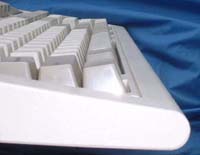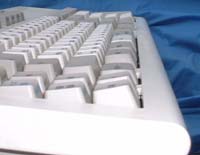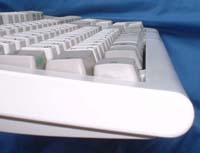|
5576 Keyboard Series
| I hereby declare that most of contents regarding key mechanism
and history of IBM keyboards written in this section are mostly based on
( and refereed to ) following sites, " Kenjin
" maintained by pseudonym IT , "Qwerters
Clinic" maintained by Mr. Tanaka . Also I referred to many useful
web sites which will be introduced here and there in the following scripts.
Great thanks to the Editors of those great pages . |
Brief
introduction
Keyboard for Multistation 5550
Before talking about 5576 keyboards, I'd
like to introduce keyboard for Multistation 5550, computers sold
by IBM Japan before MCA PS/55 series.
5556 keyboard is known as associated keyboard for
Multistation series. 5556 somehow looked like keyboard for "The PC"
( and PC/XT ), but the key mechanism used for 5556 was different
from that of The PC which used clicky Buckling spring technology.
IBM Japan ordered Alps Electric Co. Ltd. new key switch and Alps made their
unique
"Leaf Spring" and "mechanical contact" switch. Though the
Alps switch used for 5556 and alternate keyboards for Multistation series
didn't provide clicking noise, the key mechanism was actually a kind of
so-called "Mechanical Key".
I have not yet touched the keyboard actually
so I can't say how the keyboard feel like. Scan code
set used with
these keyboards ( 5556 and other alternatives ) are deferent from AT code set
so these keyboard can't be used for decent windows PCs.
Here you can see photo images of 5556
and
4773313
( the site is maintained by Mr. IT, pseudonym ) and also you
can compare how they differ from IBM
"The PC" Keyboard and alternatives.
Edit; you can see some of multistation keyborad here
.
5576 series, for PS/55.
US IBM introduced their great 101 keys Enhanced keyboard
with Buckling spring/Membrane contacts mechanism along with PS/2 in 1987.
But IBM Japan didn't use IBM's own products but again used Alps key
switch "with tactile feels and audible clicking sound" for their new PC series PS/55,
Japanese localized PS/2. Thus keyboard 5576-001 and 002 introduced
to the market.
Key layout of 5576-001 is very different from that of
Model M. Roughly speaking it looks like 1390876
. It has 24 function keys and 10 enhanced keys and was essentially
designed to be used with PS/55s as a terminal machines of mainframes (
of course those could be used as usual PC systems ).
5576-002 has 106 keys ( 5 keys are added in order to
provide Japanese environment ) and more looks like Model M layout.
Major difference of its layout is that 002 does not have left "Alt"
key as like as 001.
Later on when IBM Japan tended to consumer market with
their DOS/V technology, they made new keyboard, 5576-A01, which was based
on 002 but the key layout was rearranged and was followed to Model M to
keep operative compatibility.
For the new keyboard, IBM Japan ordered Brother Industries.
Ltd. to make "Buckling spring key" under cross-license to meet with
Japanese users' taste.
As described above, PS/55 keyboards are bit
different from PS/2 world. The Model M is really a great keyboard
and there are so many M-maniacs in Japan too, but at least for me both
5576-002 and 5576-A01 are the second to None ( no joke here ). I like 5576-002
and A01.
Back to top
Characteristic
Features of 5576 Keyboards
| |
Key
|
mechanism |
|
| 5576-001 |
124 keys |
Leaf spring mechanism |
Alps switch, PS/55 layout |
| 5576-002 |
106 keys |
Leaf spring mechanism |
Alps switch, PS/55 layout |
| 5576-003 |
99 keys |
Buckling spring mechanism |
Brother switch, PS/55 Layout |
| 5576-A01 |
106 Keys |
Buckling spring mechanism |
Brother Switch, OADG *1DOS/V
layout |
| 5576-C01 |
98 keys |
Buckling spring mechanism |
ditto , with Trackpoint II |
| 5576-B01 |
106 keys |
Rubber dome mechanism |
OADG DOS/V layout |
| and more......
OADG *1 ;
Open Architecture Developers' Group ( a consortium leaded
by IBM Japan to distribute IBM Japan's new technology regarding Japanese
( double bytes characters ) handling on DOS without any help of
special hardware but just 2MB of RAM and 386SX CPU and higher with some
added device drivers to PC DOS ( or MS DOS ) . |
Except key switch mechanism and the layout of the keys, 5576 series
are very similar to model M.
-
Both use Mechanical spring ( 5576-001/002 use
Leaf
Plate Spring though
)
-
"tactile" feedback with clicking sound
-
Curved sculpture design were applied
-
Removable key caps are used
-
Keyboard cable is detachable from a keyboard unit
Edit; Plate spring switches are introduced as Leaf
Spring switches in another famous sites.
But
said switch is described as Low Profile push button switch with audible feedbak
and
the
spring is referred as *plate spring* in the paper.
To
avoid confusion with leaf springs used in other mechanical ALPS switches, I
may
refer
this Low Profile switches used in 5576-001/002 as *Plate Spring Switches*
.
Mechanical
spring and clicking sound
I'm not a technical writer and I don't know much about key mechanism.
So I'd like to quote some nice pages relating keyboard mechanism
though those pages are mostly written in Japanese ( but you can observe
key mechanism through photos ). Alps mechanical switch ( Plate Spring with mechanical contacts
) used for 5576-001 and 002
http://park16.wakwak.com/~ex4/kb/tech_alps_5576001.htm
Brother switch ( buckling spring with membrane contacts)
http://park16.wakwak.com/~ex4/kb/tech_bucklingspring.htm
Curved sculpture
http://nextire.hp.infoseek.co.jp/pc/5576-002.html
| Actually this page is explaining difference of earlier
002 and latter 002, but the pictures show curved layout of keys and base
plates. |
Or see these pictures ( Localized
Curved sculpture )
| Model M. |
|
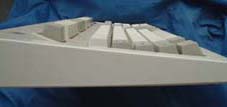
|
As you know, it is Model M, familiar to
you PS/2 lovers.
From the bottom around space bar to the top around function keys, key
tops keep curved shape. Arrangement of function keys is very unique. |
| 5576-001 |
|

|
From space bar to upper numeric keys are in curved sculpture
layout. Key tops of function keys in 2 rows are parallel to surface
of keyboard base. |
| 5576-A01 ( and 002/003 ) |
|
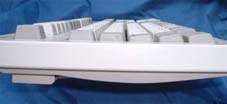 |
Same as 001.
Height of key tops of function keys from a surface of desk when
keyboard are tilted up using legs.
M ; aprrox 6.0cm
5576 ; approx 5.5cm
For a man with big hands and long fingers, M would be better. |
|
Distinctive difference ( shape of the
space bar )
 |
Could you notice the fact that the middle key
( same position of left Ctrl of Model M ) is slightly shorter
than the neighboring right key which is marked as Caps Lock (
it's 001 keyboard ) ? The Ctrl key at the right side
is in same height. These two keys are usually pressed with little
fingers, and (at least for Japanese ) this modification makes us easier
to type those keys. |
Back to top
Removable key caps
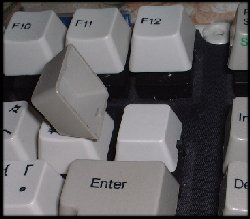 |
dimension of key tops and caps are different
from model M These are not compatible among 5576s and Ms. |
| 5576-A01 |
|
K/B plug
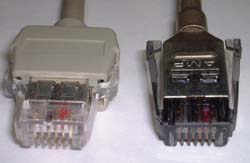 |
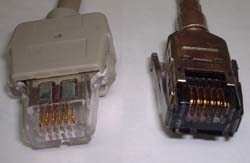 |
| Upper side L; PS/55 R; Model M |
Bottom side ( from pin ) L; PS/55 R; Model M. |
Pin-out of PS/2 connector and K/B Plug
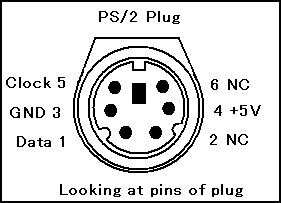 |
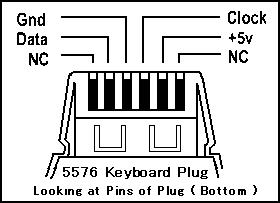 |
| Original outlines were
drawn by John Szybowsky. Click here
for original outlines |
Compatibility
issue ( For Japanese readers only )
There are compatibility issue for 5576-001/002/003 regarding their
S/N and EC level to use with some of PS/55s. Please read here.
OS support ( 001/002/003 only )
Win ME doesn't support 001/002/003.
Win2000/XP does have keyboard dll file for 001/002/003 but you
can't select these keyboard using device manager. If you can rewrite
keyboard.inf you can do that.
If not , you have to manually set dll file modifying windows registry.
Information is found here.
Take care.
Back to top
5576-001
( 5576 Keyboard-1 P/N 94X1220 )
-
Alps made Plate-Spring Key Switches with Mechanical contacts
-
Audible and tactile feedback ( it actually has a SP at the
bottom )
-
124Key Japanese 001 layout
-
Removable Key Caps
-
Detachable Keyboard cable
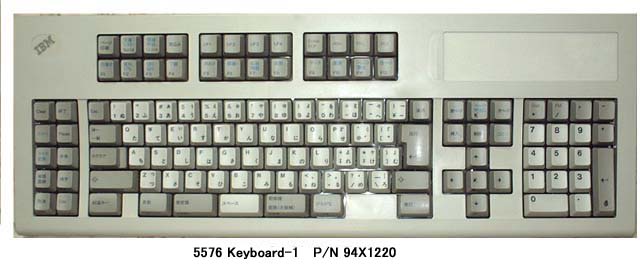
|
Thin but huge keyboard this one is. It has
24 function keys and 10 enhanced keys. Key layout looks like
that of Emulator 122.
Enhanced keys were basically for IBM Japan's proprietary word Processing
software " DOS Bunsho Program " which had been sold since Multistation
5550 series. PS/55s were sometimes used as terminal emulators at some big
companies along with Multistation series. So the key layout was not
so ridiculous at that time, I suppose. |
|
Alps Key switches
gives really good response. Requires lesser pressing force
than Model M. but gives firm and sure typing response.
Not so loose as Model M, gives tight clicking sound ( reverberation
of metal spring is tight and firm comparing to Model M ). Disadvantage
of this keyboard is it's unique key layout. Win95/98 support
this keyboard in native but neither Win 2000 nor XP provide keyboard
file officially( though both of them have keyboard dll for this keyboard
and it is possible to use it rewriting window's registry data ). |
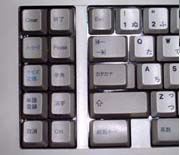 |
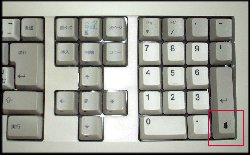 |
| Enhanced keys |
Cross-layout cursor keys |
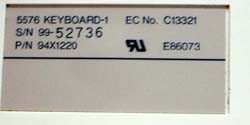 |
|
|
label
|
|
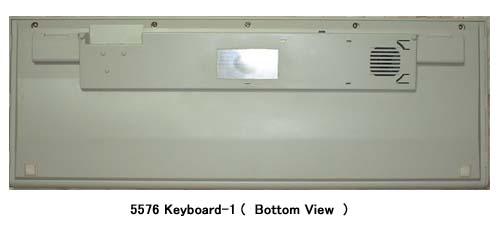 |
|
SP unit is actually placed inside the SP grill.
|
Back to top
5576-002
(
5576 keyboard-2 P/N 94X1110 )
-
Alps made Plate Spring Key Switches with Mechanical contacts.
-
Audible and tactile feedback ( it actually has a SP at the
bottom )
-
106 Key Japanese 002 layout
-
Removable Key Caps
-
Detachable Keyboard cable
| Also uses Alps Key switches with mechanical
contacts. Key response is basically same with 001 keyboard. It doesn't have added 12 function keys and 10 enhanced keys seen in 001.
Key Layout is nearly same with latter A01 model and thus the layout
is supposed to be origin for that of A01. Main difference is that
002 dose not have Alt Key at left side of space bar, it
has only one Alt key at the right side. |
Alternative of this keyboard is labeled as 55760N2
with P/N 07G3331 |
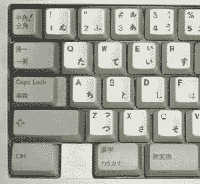 |
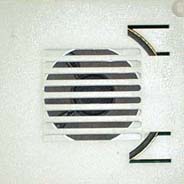 |
| Kanji key below Z/X |
SP unit inside the grill |
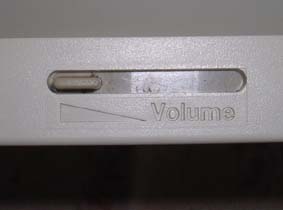 |
|
| sliding Volume bar for adjusting SP level |
|
Back to top
5576-003
( 5576 Keyboard-3 P/N 66X1121 )
-
Brother made Buckling Spring system
-
Membrane contacts
-
tactile feedback with clicking sound
-
89Key Japanese A01 Layout
-
Removable Key Caps
-
Detachable Keyboard cable
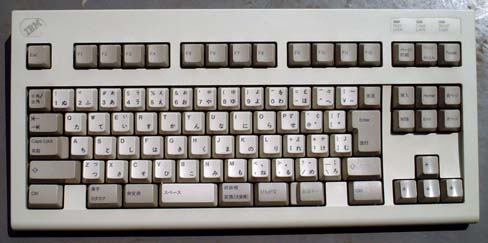 |
|
5576 Keyboard-3 P/N 65X1121
|
| Key layout is same with 5576-002 ( Keyboard-2 ) . As you can see, this
model has no numeric key sections. Key switch mechanism used for this model
is not Alps but Buckling spring switches made by Brother
Industry Co. Ltd which is also used in 5576-A01. Mine feels somehow
different from A01. I may be wrong but I feel 003 is bit lighter than
A01. |
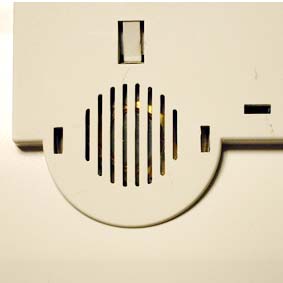 |
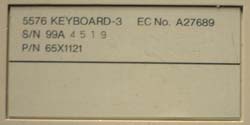 |
|
Upper;
Label
Left; SP unit
|
Back to top
5576-A01
( P/N 79F0167 )
-
Brother made Buckling Spring system
-
Membrane contacts
-
tactile feedback with clicking sound
-
106Key Japanese A01 Layout
-
Removable Key Caps
-
Detachable Keyboard cable
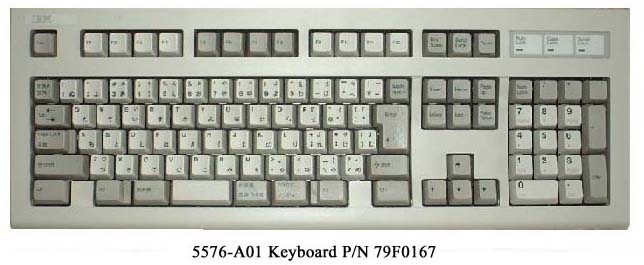 |
My favorite one. Have no appropriate words to describe
how good it is.
Requires much pressing force than 002 keyboard and repercussion may
be harder than 002.
But I like it.
Please visit here
for the mechanism of this keyboard. The site is maintained by Mr.Tanaka.
you can observe how the key spring works in moving photo images.
|
|
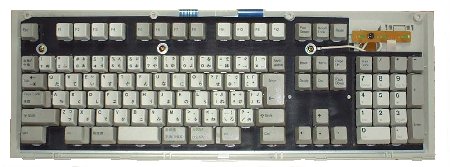 |
|
Inner view
By the way, I misplaced some key caps after cleaning caps to take
pictures.... |
Back to top
5576-C01
(
With a TrackPoint-II, kind of SpaceSaver )
-
IBM Buckling spring system
-
Membrane contacts
-
tactile feedback
-
89Key Japanese A01 Layout
-
cabke is dirrectly connected , not detachable.
No picture is available. Please check this
site for pictures of C01 keyboard.
Most possibly this one is US IBM's products for IBM Japan. Original
model of this keyboard might be Model
M13 Trackpoint II (92G7461 ). Or Eudora
Pro UNI04G6 made by Unicomp. Outlook is
almost same with each other except UNI04G6 does not have a rotating
bar used as a leg to keep the keyboard vertically when it is not in
use. I do not know whether IBM Japan designed 5576-C01 and ordered
US IBM to make it or US IBM had already had that kind of
pre-production model and
just arranged key layout to meet with Japanese market. This keyboard was introduced to the market as associated keyboard of
earlier models of PS/55E 5538 and 5537. As I wrote
in 5538 section, there are two types of this model, one is with with
single cable to be connected to K/B port of 5537/5538 and the other is with "Y cable" separated to K/B connector
and mouse connector. The former is P/N 66G8363 and the latter is
P/N 66G8362. Please see 5538 section
too.
Key touch response is ... not so good . It might be derived from
Model M and actually it gives tactile feedbacks but it is not "M".
Design is good, product concept is also good, Track-point II on a standard
full-key layout may save space for mouse operation. Buckling spring
technology should be good but...could it be better ? It gives you
just noisy tactile sounds. Do not expect C01 for model M's
quality. You'll be disappointed,
I swear it.
There are few more keyboard numbered as 5576 made after A01, but
they are mainly sold with Aptiva or new IBM PC series with which
Rubber Dome spring mechanism and Membrane contacts were applied.
These are not my choice .
5576-B01
Some people says this one is included to mechanical K/B but as far
as I can see, this one uses conductive rubber dome springs
Actually it is different from today's usual cheapo K/B and it gives
relatively firm typing feel but so far it was the starter of IBM's cheap K/B (
and the End of the High quality Desktop keyboard ).
5576-B05
Back to top
PS/55 Index Page
|




